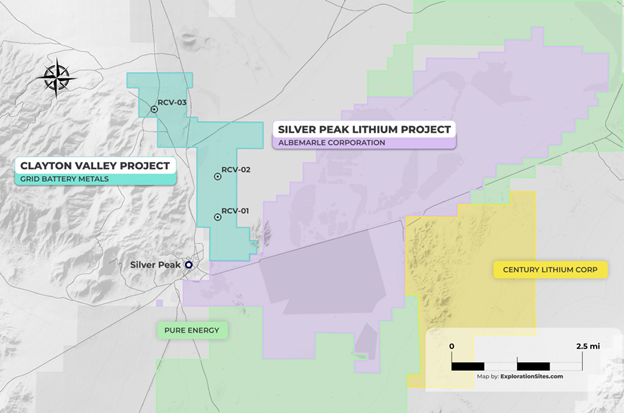Grid Battery Metals Completes Phase 2 of its 2024 Clayton Valley Project 2024 Exploration Plan
Grid Battery Metals has completed the second phase of its 2024 exploration plan for the Clayton Valley Project. This phase involved detailed soil sampling and the integration of geological data using advanced modeling techniques. The first phase resulted in 166 samples showing significant lithium potential, while the second phase refined these findings with 286 additional samples. Assay results are pending. The exploration also included the use of magnetotelluric (MT) geophysics to better understand subsurface structures, which will guide future drilling. The company is optimistic about the project's potential, especially given the proximity to Century Lithium's positive feasibility study and Albemarle 's lithium production facility in the same region.
- Completion of two soil sampling phases with a total of 452 samples, indicating potential lithium deposits.
- Integration of geological, geophysical, and geochemical data into a 3D model for improved drill targeting.
- Use of advanced modeling techniques to understand subsurface structures, increasing chances of lithium discovery.
- Proximity to Century Lithium's positive feasibility study and Albemarle's lithium production facility, enhancing project attractiveness.
- Pending assay results, leaving uncertainty about the definitive lithium content and quality.
- No immediate financial gain or production increase reported from the completed phases.
COQUITLAM, BC / ACCESSWIRE / June 20, 2024 / Grid Battery Metals Inc. (the "Company" or "Grid") (TSXV:CELL)(OTCQB:EVKRF)(FRA:NMK2) is pleased to announce the conclusion of a second phase of soil samples and the construction of a geologic model incorporating mapped geology, magnetotelluric (MT) geophysics, and soil geochemistry. Grid's exploration team has determined that a multilayered approach to drill targets would improve the chances of intercepting lithium bearing brines.
The initial soil sample program was completed in March 2024 and consisted of 166 samples on a 250 x 250 meter grid. The results of this program show a sizeable cluster of +300 ppm samples at the south end of the claims, and a generally northeast trending cluster of 100-300 ppm samples that extend to the north-central portion of the claims (Figure 1).
A second infill phase was completed in early May 2024 over a 125 x 125 meter grid (Figure 2) and consists of 286 samples. The objective of the infill sampling is to refine grade breaks identified in phase 1 to better focus drill targeting. Assay results are pending.
Recent Infill Soil Samples Taken (Clayton Valley Lithium Project)

Figure 1: Clayton Valley Phase 1 soil sampling results.

Figure 2: Clayton Valley infill Phase 2 soil samples.
To better understand the underlying structure of the Clayton Valley claims, 2024 MT data, and publicly available geologic maps and DEM data were incorporated into a Leapfrog model by Mr. Ben Hinkley of Rangefront Mining Services. The geologic mapping used is from a 2008 summary report of a geothermal exploration program in Clayton Valley in 2007 (Hulen, 2008). Both mapped and inferred faults were used to create fault blocks. Figure 3 shows the geologic map used, and the Grid land shape both draped on a topographic DEM.

Figure 3: A Leapfrog model with faults and fault blocks. The darked image to the right of the topographic DEM image includes the Grid land shape.

Figure 4: Oblique view of the Clayton Valley geologic model without claims on the left and with claims on the right.
Apparent resistivities and XYZ coordinates from each MT (1d and 2d) line were imported into Leapfrog as a numeric model, and isosurfaces (3d contours) were generated for various resistivities. 2D resistivities of <1 and 1-5 show the tightest structural focus to the northeast suggesting the most conductive brine is focused along the circled northeast fault (Figure 5).

Figure 5: 2D resistivity isosurfaces for <1 ohm-m on the left and 1-5 ohm-m on the right
All soil assays will be contoured as a horizontal surface and will then be draped on topography in Leapfrog. The expectation is that the soil contours and MT contours will enable the best placement of drillholes that are driven by structure, geophysics, and geochemistry.
Grid's Clayton Valley Lithium Project (RC Drilling Locations Identified)

Tim Fernback, Grid President & CEO comments "Recently, Century Lithium (TSXV: LCE, OTCQB: CYDVF) our neighbor to the east) has just released their Positive Feasibility Study by T. Lane et al. (2024). Measured and Indicated resources totaling 1,207.33 million tonnes (Mt) at an average grade of 957 parts per million (ppm) lithium (Li) containing 1.155 Mt of Li or 6.148 Mt of lithium carbonate equivalent (LCE), a 40-year mine life and an after-tax NPV8 of
It should be noted that results from any adjacent property(s) are not an indication of what may be found on the Company's property(s).
About Rangefront Geological
Elko Nevada-based Rangefront Geological has combined in-depth expertise with cutting-edge technology to provide mining consulting services, contract labor, field crew services, and vehicular support to the mining industry. With services available across North America, Rangefront works closely with its clients to provide high-quality mineral exploration services.
Qualified Person
Mr. Steven McMillin, P.G. is a Qualified Person as defined by National Instrument 43-101 and has approved the technical information contained within this news release.
About Grid Battery Metals Inc.
Grid Battery Metals Inc. is a Canadian based exploration company whose primary listing is on the TSX Venture Exchange. The Company's maintains a focus on exploration for high value battery metals required for the electric vehicle (EV) market.
About Texas Springs Property
The Company owns a
The Texas Spring property adjoins the southern border of the Nevada North Lithium Project - owned by Surge Battery Metals Inc. ("Surge") (TSXV: NILI, OTC: NILIF) and comprised of 725 mineral claims. Surge's first round of drilling identified strongly mineralized lithium bearing clays. The average lithium content within all near surface clay zones intersected in the 2022 drilling program, applying a 1000 ppm cut-off, was 3254 ppm. (Press release March 29, 2023). More recent results have shown higher grade lithium up to 8070 ppm on this property after initial drilling (Press release September 12, 2023). Our exploration results are on-trend with these results.
About Clayton Valley Lithium Project
The Company owns a
Volt Canyon Lithium Property
The Company owns a
References
Hulen, Jeffrey B., 2008, Geology and Conceptual Modeling of the Silver Peak Geothermal Prospect, Esmeralda County, Nevada, Technical Report for Sierra Geothermal Power Corporation, http://gdr.openei.org/files/268/Silver%20Peak%20Geology%20Map%20and%20Model%20(Hulen)%20Jul%202008.pdf.
Prefeasibility Study Clayton Valley Lithium Project, Esmerelda County, Nevada, August 5, 2020, Amended March 15, 2021, Todd Fayram MMSA-QP (CMS), Terre A. Lane MMSA-QP (GRE), J.J. Brown, SME-RM (GRE), NI43-101 Technical Report for Century Lithium
Century Lithium Announces Positive Feasibility Study for the Clayton Valley Lithium Project, Nevada, April 29, 2024, Terre A Lane MMSA-QP (GRE), Hamid Samari, Principal Geologist, Todd-Fayram, Sr. V.P Metallurgy-Century Lithium, Alan Drake, Process Engineering, Haiming (Peter)Yuan Principal Geotechnical Engineer, Paul Blauch, Technical Director, Farza Kossari, Cost Estimating Engineer, Century Lithium Press Release.
On Behalf of the Board of Directors
"Tim Fernback"
Tim Fernback, President & CEO
Contact Information:
Email: info@gridbatterymetals.com
Phone: 604- 428-5690
Neither the TSX Venture Exchange nor its Regulation Services Provider (as that term is defined in the policies of the TSX Venture Exchange) accepts responsibility for the adequacy or accuracy of this release. This news release may contain forward-looking statements which include, but are not limited to, comments that involve future events and conditions, which are subject to various risks and uncertainties. Except for statements of historical facts, comments that address resource potential, upcoming work programs, geological interpretations, receipt and security of mineral property titles, availability of funds, and others are forward-looking. Forward-looking statements are not guarantees of future performance and actual results may vary materially from those statements. General business conditions are factors that could cause actual results to vary materially from forward-looking statements. It should be noted that results from any adjacent property(s) are not an indication of what may be found on the Company's property(s).
SOURCE: Grid Battery Metals Inc.
View the original press release on accesswire.com
FAQ
What is the progress of Grid Battery Metals' Clayton Valley Project as of June 2024?
What were the findings of the initial soil sampling in Grid Battery Metals' Clayton Valley Project?
When were the soil sampling phases for the Clayton Valley Project completed?
How many samples were collected during the second phase of the Clayton Valley Project?
What technologies were used in the Clayton Valley Project to identify drill targets?







